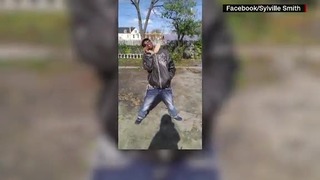After a tumultuous weekend mired in protests and violence, many Milwaukee residents hoped for calm.
The city, long marred by racial tensions, instituted a curfew for teenagers Monday night in an effort to restore the peace after Saturday’s shooting death of an armed African-American man, Sylville Smith, by a black police officer.
Protests over the shooting turned violent over the weekend as at least six businesses were torched, cars were burned and four officers injured in the clashes. The damage was not as extensive the following night, but shots rang out in three locations, and an 18-year-old man who was struck in the neck was hospitalized, police said. At least seven officers were wounded, including some who were hit by rocks and bricks.
By Monday morning, many residents called for healing as prayer circles formed in the neighborhood in which the businesses were burned.
A night of peace for Milwaukee?
Milwaukee Mayor Tom Barrett said the new 10 p.m. curfew for teenagers would stay in effect as long as it was necessary. The curfew is normally in effect in the city during the school year, which begins August 31.
Late Monday night, Barrett and Milwaukee Police Chief Edward Flynn struck a cautiously optimistic note that the events from the weekend would not repeat again.
“We see great improvement over yesterday,” said Flynn. Six people had been arrested Monday, he added.
Barrett and Flynn credited community and faith leaders for meeting with residents and calling for calm.
The tumult was confined to the northern Milwaukee neighborhood of Sherman Park, which was closed at 6 p.m. Monday, prompting demonstrators to relocate to a park adjacent to the gas station.
By nightfall, tensions appeared to level off, with the exception of a few brief clashes between protesters and police at the park. Otherwise, a prayer vigil led by members of a local church and the Salvation Army continued without incident.
Flynn noted that residents holding prayer circles and a barbecue was “certainly very encouraging.”
“The vast majority of the residents are not interested in doing damage to where they live,” he said.
The violence over the weekend had prompted Wisconsin Gov. Scott Walker to declare a state of emergency on Sunday.
What prompted the violence
The protests began hours after a police officer shot Smith on Saturday.
Smith’s encounter with police began when a pair of officers stopped him and another person in a car Saturday afternoon, police said. The men fled the car, and the officers followed, shooting Smith in the arm and chest when he failed to put his gun down, Barrett said.
Smith’s handgun, along with 500 rounds of ammunition, were stolen during a burglary in nearby Waukesha in March, police said.
Police body camera footage showed Smith holding a handgun during the encounter, Barrett said. Police said the officer shot Smith after he failed to comply with orders to put his gun down. His gun was loaded with 23 rounds, more than the officer was carrying.
Smith died at the scene, and no officers were injured. The unidentified officer who shot the fatal rounds is 24 and has six years of service with the Milwaukee police — three as an officer. He will be placed on administrative duty during an investigation.
Smith’s sister Kimberly Neal mourned a brother she described as a high school graduate who played basketball, not a “man with a lengthy arrest record” described by police.
“He should have been tased, if anything,” she said.
By state law, the Wisconsin Department of Justice will lead the investigation. Wisconsin was the first state to enact a law requiring an independent investigation of a death involving law enforcement, the governor said.
‘Worst place to live for African-Americans’
The police shooting brought many of the festering racial tensions to surface.
Alderman Khalif Rainey said the area has been a “powder keg” for potential violence throughout the summer.
“What happened … may not have been right, and I am not justifying that, but no one can deny the fact that there are problems, racial problems in Milwaukee, Wisconsin, that need to be rectified,” Rainey said. “This community of Milwaukee, Wisconsin, has become the worst place to live for African-Americans in the entire country.”
Rainey said Saturday’s violence was a byproduct of inequities, injustice, unemployment and lack of educational opportunities.
Racial tensions have long permeated the city.
“People are afraid of each other,” resident Reginald Jackson said last year. “Black people are afraid of the white parts of town. White people are afraid of the black and Latino parts of town.”
Statistics back up Jackson’s claim. Milwaukee is the most segregated major city between black and white residents, according to a city of Milwaukee health assessment.
White residents from suburban Milwaukee often avoid the northern, mostly black part of the city, driving around it.
